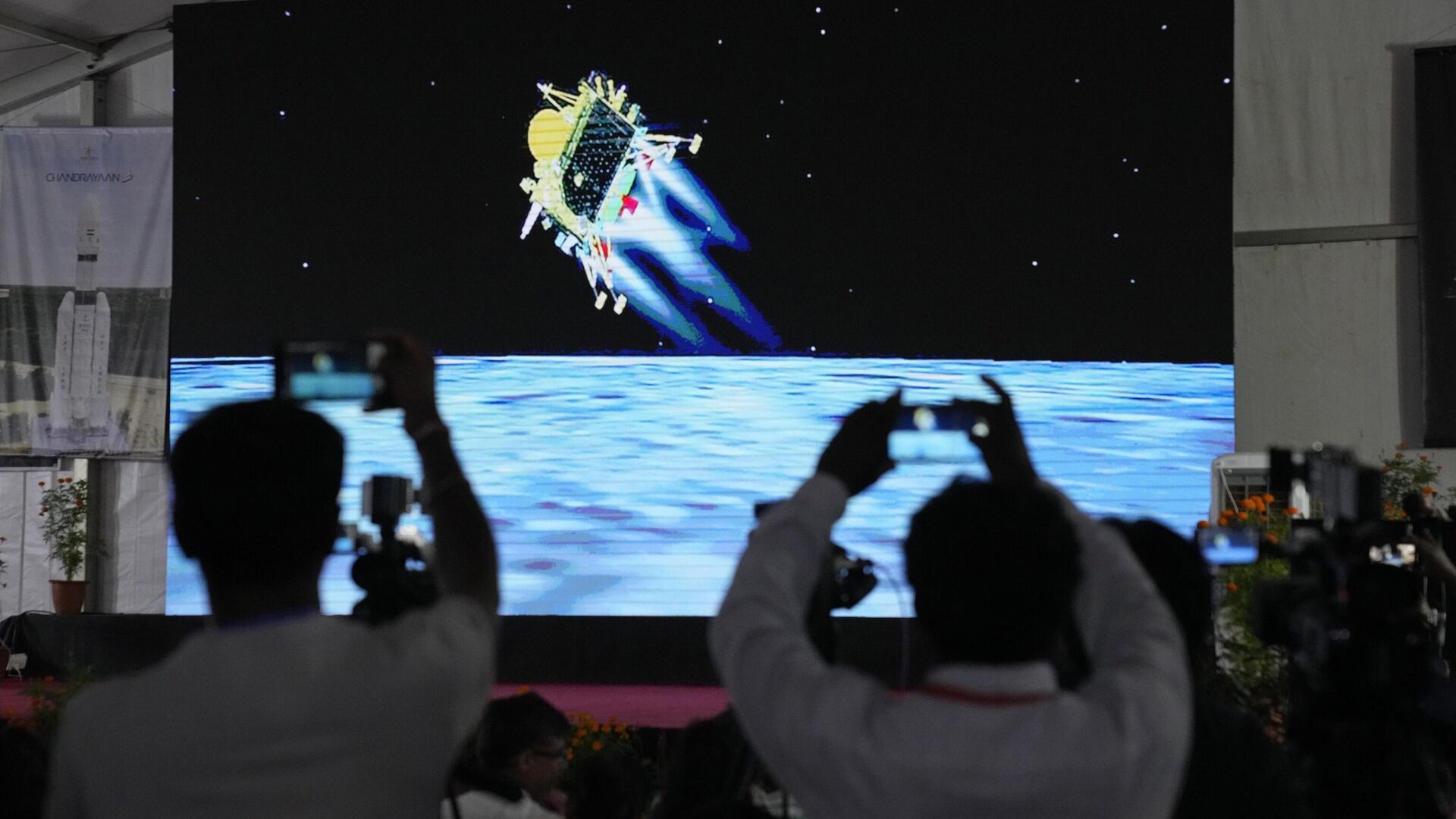https://sputniknews.in/20231205/chandrayaan-3s-propulsion-module-shifts-from-lunar-to-earth-orbit--5706754.html
Chandrayaan-3's Propulsion Module Shifts from Lunar to Earth Orbit
Chandrayaan-3's Propulsion Module Shifts from Lunar to Earth Orbit
Sputnik India
The Propulsion Module (PM) of Chandrayaan-3 has been moved from the Moon's orbit to Earth's orbit, ISRO announced.
2023-12-05T13:48+0530
2023-12-05T13:48+0530
2023-12-05T13:48+0530
science & tech
science & tech
moon
indian space research organisation (isro)
chandrayaan
space satellite
space industry
space exploration
moon mission
moon landing
https://cdn1.img.sputniknews.in/img/07e7/09/01/3971742_0:160:3072:1888_1920x0_80_0_0_b92f3423227c614d2d741e3dbedfbc61.jpg
The Propulsion Module (PM) of Chandrayaan-3 has been moved from the Moon's orbit to Earth's orbit, ISRO announced.Chandrayaan-3 was initially planned to achieve a successful soft landing on Moon's South Pole. Indian space agency accomplished the mission objective on 23 August when Vikram Lander made a touchdown on the Moon's surface, and the Pragyaan rover operated continuously for one lunar day (14 days on Earth).“The precise orbit injection by LVM3 and optimal earth / lunar burn maneuvers, resulted in the availability of over 100 kg of fuel in the PM after over one month of operations in the lunar orbit. It was decided to use the available fuel in the PM to derive additional information for future lunar missions and demonstrate the mission operation strategies for a sample return mission,” the space agency added.The first maneuver was performed on 9 October to raise the apolune altitude to 5112 km from 150 km, thus increasing the period of orbit from 2.1 hours to 7.2 hours. Later, more maneuvers were performed. On 23 August, India became the fourth nation to achieve a soft landing on the Moon after Russia, the US, and China.
https://sputniknews.in/20231124/chandrayaan-4s-big-challenge-is-transporting-moon-soil-back-to-earth-expert-5559414.html
moon
russia
Sputnik India
feedback.hindi@sputniknews.com
+74956456601
MIA „Rossiya Segodnya“
2023
Deexa Khanduri
https://cdn1.img.sputniknews.in/img/07e6/0c/13/138923_52:0:533:481_100x100_80_0_0_cadf23d341691fc65ff2b22fd1afe584.jpg
Deexa Khanduri
https://cdn1.img.sputniknews.in/img/07e6/0c/13/138923_52:0:533:481_100x100_80_0_0_cadf23d341691fc65ff2b22fd1afe584.jpg
News
en_IN
Sputnik India
feedback.hindi@sputniknews.com
+74956456601
MIA „Rossiya Segodnya“
Sputnik India
feedback.hindi@sputniknews.com
+74956456601
MIA „Rossiya Segodnya“
Deexa Khanduri
https://cdn1.img.sputniknews.in/img/07e6/0c/13/138923_52:0:533:481_100x100_80_0_0_cadf23d341691fc65ff2b22fd1afe584.jpg
chandrayaan 3, chandrayaan 3 launch date, chandrayaan, chandrayaan-3, chandrayaan-3 launch date, chandrayaan 3 upsc, photos of chandrayaan, india moon mission, india's moon mission, moon mission, pragyan rover, what is vikram lander and pragyan rover, what chandrayaan will do on moon, is chandrayaan sucessful, vikram moon rover, चंद्रयान-3
chandrayaan 3, chandrayaan 3 launch date, chandrayaan, chandrayaan-3, chandrayaan-3 launch date, chandrayaan 3 upsc, photos of chandrayaan, india moon mission, india's moon mission, moon mission, pragyan rover, what is vikram lander and pragyan rover, what chandrayaan will do on moon, is chandrayaan sucessful, vikram moon rover, चंद्रयान-3
Chandrayaan-3's Propulsion Module Shifts from Lunar to Earth Orbit
Deexa Khanduri
Sputnik correspondent
The Indian Space Research Organisation (ISRO) has successfully completed the unique experiment of moving the Chandrayaan-3 Propulsion Module (PM) from the Lunar orbit to the Earth's orbit, ISRO announced.
The Propulsion Module (PM) of Chandrayaan-3 has been moved from the Moon's orbit to Earth's orbit, ISRO announced.
Chandrayaan-3 was initially planned to achieve a successful soft landing on Moon's South Pole. Indian space agency accomplished the mission objective on 23 August when Vikram Lander made a touchdown on the Moon's surface, and the
Pragyaan rover operated continuously for one lunar day (14 days on Earth).
"With regard to the Propulsion Module, the main objective was to ferry the Lander module from geostationary transfer orbit (GTO) to the final lunar polar circular orbit and separate the Lander. Subsequent to separation, Spectro-polarimetry of Habitable Planet Earth (SHAPE) payload in the PM was also operated. The initial plan was to operate this payload for about three months during the mission life of PM," the press release issued by ISRO reads.
“The precise orbit injection by LVM3 and optimal earth / lunar burn maneuvers, resulted in the availability of over 100 kg of fuel in the PM after over one month of operations in the lunar orbit. It was decided to use the available fuel in the PM to derive additional information for
future lunar missions and demonstrate the mission operation strategies for a sample return mission,” the space agency added.
The first maneuver was performed on 9 October to raise the apolune altitude to 5112 km from 150 km, thus increasing the period of orbit from 2.1 hours to 7.2 hours. Later, more maneuvers were performed.
"Hence as per current orbit prediction, there is no threat of close approach with any operational Earth-orbiting satellites," ISRO said.
On 23 August, India became the fourth nation to achieve a soft landing on the Moon after
Russia, the
US, and
China.



